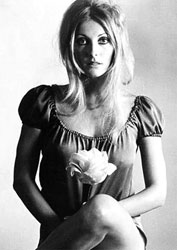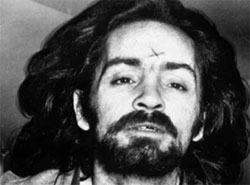March 27, 2006
History can make for great TV. For if we don't dramatize the past, then we're just...
Doomed to rerun itCharlie Made Me Do It
How NOT to do a historical "remake": serial killer style
 |
The next day, the housekeeper makes a frantic 911 call. Police would later report they found Parent dead in his car, four gunshot wounds to his head. Frykowski was on the lawn, his skull crushed by 13 blows to the head as well as being shot twice, a total of 51 stab wounds in his body. Folger lay not too far away. She had been stabbed 21 times. Inside the home, they found the body of Sebring, shot and stabbed seven times. A nylon rope was tied around his neck and thrown over a beam in the ceiling. Attached to the other end of the rope was the corpse of an eight-and-a-half months pregnant Sharon Tate. On the open front door to the home, police found the word "pig" written in Tate's blood.
If all this wasn't horrifying enough, with time it would be discovered that this wasn't the first of the murders — nor would it be the last. Eventually it would be discovered that a group of young women and men had done the killings on the orders of one Charles Manson, who was attempting to start what he called "Helter Skelter"; a race war between blacks and whites that would be "the war to end all wars". And yes, it WAS inspired by the Beatles song. What followed was one of the most complicated and bizarre murders trials in the history of United States law.
Less than ten years after the Manson Family murders, CBS announced it was going to air a television mini-series based on Vince Bugliosi's novel Helter Skelter. Bugliosi was the lead prosecuting attorney at the murder trial and his extremely well-researched and balanced novel is a classic in the True Crime genre. Helter Skelter aired Thursday, April 1 and Friday, April 2, 1976 and was the highest-rated telecast of the 1975-1976 television season. Nearly 60 percent of TV sets were tuned to Helter Skelter. This was especially impressive considering the distribution problems the project suffered. Several CBS stations across the country delayed the telecast, refusing to air the miniseries in prime time and seven CBS stations refused to air it altogether. Plus, the CBS station in Los Angeles, the nation's second-largest television market, decided to postpone the broadcast for weeks because Bugliosi was running for office in the city at that time. A Washington Post review predicted that CBS would come under fire for showing the miniseries, stating, "There will be a lot of criticism, much of it centered on the relationship between violence on television and violence in this society, the remainder charging CBS with exploiting violence in pursuit of higher ratings."
| This new adaptation focuses on who Manson was, why he did what he did and how this morally corrupt ex-con persuaded the members of his Family to commit such horrifying acts". The "remake" barely made a blip on the ratings scale. |
So why did one work while the other failed miserably? First of all, there is a fine line between making a "remake" your own while still staying true to the original work. I'll admit it was a tall order, having both a bestselling novel AND a highly successful television miniseries to look up to. But the 2005 version barely even attempted to honor the original miniseries. Part of the problem was that there seemed to be a disproportional amount of focus on us getting to know the victims of the murders, which was perhaps a decision made based on the amount of time that has passed. In 1976, most people were still acutely aware of the murders, having been alive at the time to witness them. Now, almost 30 years later, maybe the audience needed to really have the horror recreated for them. The result is a constant bombardment of images of the murders dispersed throughout the entire two plus hours of the film, complete with slow-mo and Tate begging to live so she can have her baby. Then there is the little problem of conversations occurring between Folger and Tate, Tate and Sebring, etc. Seeing as no one was left alive who could have witnessed these conversations, they are complete fabrications, something which the original novel and miniseries were meticulous about avoiding.
 |
Each version of Helter Skelter contains a very specific focus, one which I feel works while the other is ineffective. The 1976 version is narrated by Bugliosi himself. He takes us right into the investigation, leads us through the twists and turns of missing evidence, police mistakes at the scenes of the crimes, and brings us along with him as he interviews witnesses and puts together piece by piece a case against a man whose motives for murder seem insane but must be proven sane enough to get a conviction. It's a roller-coaster ride to say the least, but we connect with Bugliosi, root for him. On the other end of the scale, the 2005 version is narrated by no one and is simply a visual representation of why Manson is Manson and why he is bad. And yes, this is what it proclaimed itself to be but something about it is very cold, very detached. There is also a great deal of focus on Linda Casabian, who was a member of the Family, was present at most of the murders, and whose testimony was the foundation on which Bugliosi built his case which lead to the convictions of not only Charlie but all the other Family members involved. Though played brilliantly by Clea DuVall, the focus on Linda in this version lead to the watering-down of characters that were pivotal to the original series success.
| She is practically orgasmic as she describes what it felt like to kill and though the woman listening to these confessions is visibly disturbed at what she is hearing, there is still an underlying sexual tension between the two. |
This same scene in the 2005 version is completely devoid of poetry. First of all, it's cut incredibly short and the ages between the two women speaking is inexplicitly increased. Marguerite Moreau plays Atkins as a vapid, happy-go-lucky, lost little girl "saved" by Charlie's love. She exudes no sexuality and simply giddily proclaims how Charlie is the absolute bestest, how murder is totally cool man. I'm not afraid of her. I'm not even particularly invested in whether she is convicted for murder or not. I just think she's dumb. To sum up, if you have a real interest in learning about the Manson Family and don't have time to invest over six hours of your time to watching these supposedly "complimentary" series, feel completely free to skip the "remake". But please, I beg of you, do not skip the original thinking it is out-of-date. Sure, you'll have to sit through a few strange editing choices and a slightly jarring score, but there are too many delicious nuances to the story and some stellar performances that you would be robbing yourself of. This story was ugly and complicated and twisted and it deserved the type of attention that was given to it in 1976.
Now that we've got all this murder talk out of the way, I'll end with a fun fact courtesy if the IMDb: Martin Scorsese was originally offered the role of Charles Manson in 1976.
Gives you shivers, doesn't it?
Email the author.
Return to Season 2, Episode 13.
All written content © 2005-2006 by the authors. For more information, contact homer@smrt-tv.com
